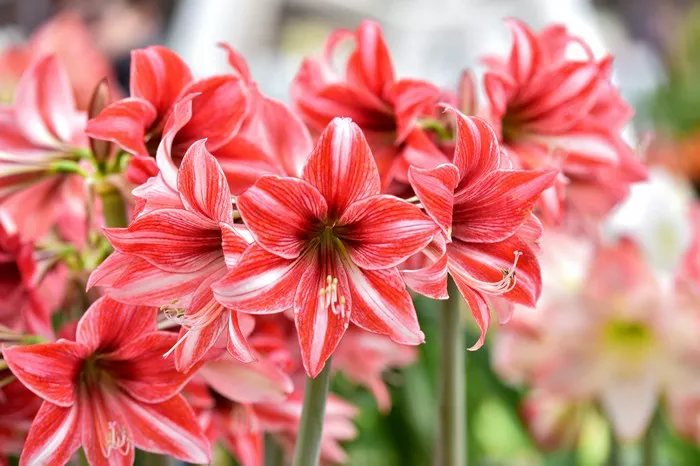Amaryllis plants, with their striking blooms and elegant stature, are popular choices for indoor and outdoor gardening enthusiasts alike. Their vibrant flowers bring joy during the winter months and beyond. However, once the blooms fade, many gardeners wonder how to care for their amaryllis plants to ensure their continued health and the potential for future blooms. Proper post-flowering care is essential for encouraging the plant to thrive and produce flowers again in the next growing season.
Understanding Amaryllis Growth Cycle
Before delving into post-flowering care, it’s crucial to understand the growth cycle of amaryllis plants. Amaryllis typically go through a dormant period after flowering, during which they store energy in their bulbs. This energy is used to fuel new growth and flower production in subsequent seasons. Providing the right care during this phase is vital for the plant’s overall health and future performance.
Post-Flowering Care Guidelines
1. Remove Faded Flowers: As soon as the blooms start to fade, snip them off with clean scissors or pruning shears. Removing spent flowers prevents the plant from expending energy on seed production, redirecting its resources toward bulb development instead.
2. Maintain Adequate Watering: During the post-flowering period, adjust your watering regimen to accommodate the plant’s changing needs. While the amaryllis bulb is still actively growing foliage, continue to water it regularly, ensuring that the soil remains evenly moist but not waterlogged. However, as the foliage begins to yellow and die back, gradually reduce watering to allow the bulb to enter dormancy.
3. Provide Ample Light: Amaryllis plants thrive in bright, indirect light. Place them near a sunny window where they can receive at least six hours of sunlight daily. Adequate light exposure during the post-flowering phase promotes robust growth and bulb development.
4. Fertilize Sparingly: While the plant is actively growing foliage after flowering, you can continue to fertilize it lightly to support healthy growth. Use a balanced, water-soluble fertilizer diluted to half-strength and apply it every two to four weeks. Once the foliage begins to yellow and die back, discontinue fertilization until the next growing season.
5. Allow Foliage to Wither Naturally: As the amaryllis bulb transitions into dormancy, the foliage will naturally start to yellow and wither. Resist the urge to remove the foliage prematurely, as it plays a vital role in replenishing the bulb’s energy reserves. Once the foliage has completely withered, you can trim it back to within a couple of inches of the bulb.
6. Initiate Dormancy Period: After the foliage has withered, it’s time to initiate the dormancy period for the amaryllis bulb. Reduce watering gradually until you stop altogether, allowing the soil to dry out completely. This mimics the dry conditions the bulb experiences in its native habitat during the dormant season.
7. Store Bulb in Cool, Dark Location: Once the bulb has entered dormancy, carefully dig it up from the soil, taking care not to damage its roots. Clean off any excess soil and inspect the bulb for signs of damage or disease. Store the bulb in a cool, dark location with good airflow, such as a garage or basement, where temperatures remain between 40°F and 50°F (4°C to 10°C). Avoid storing the bulb in a refrigerator that contains fruits and vegetables, as the ethylene gas they produce can negatively affect the bulb.
8. Monitor for Pests and Diseases: While the bulb is in storage, periodically check it for signs of pests or diseases. Common pests that may affect amaryllis bulbs include mealybugs, aphids, and spider mites. If you notice any signs of infestation or disease, take prompt action to address the issue before it spreads.
Reviving Amaryllis for the Next Growing Season
As the winter months give way to spring, it’s time to prepare your amaryllis bulb for its next growing season. Follow these steps to revive the bulb and encourage it to produce new growth and flowers:
1. Replant in Fresh Soil: In late winter or early spring, remove the amaryllis bulb from storage and inspect it for any signs of damage or rot. Discard any bulbs that appear unhealthy. Plant the remaining bulbs in fresh, well-draining potting soil, leaving the top third of the bulb exposed above the soil surface.
2. Resume Watering: Once the bulb is replanted, resume regular watering to encourage new growth. Water the soil thoroughly, allowing excess water to drain away. Keep the soil evenly moist but not waterlogged, as excessive moisture can lead to bulb rot.
3. Provide Adequate Light: Place the newly potted amaryllis bulb in a bright, sunny location where it can receive ample sunlight. Rotate the pot periodically to ensure even exposure to light and prevent the plant from leaning toward the light source.
4. Monitor Growth and Adjust Care as Needed: As the amaryllis bulb resumes growth, monitor its progress closely and adjust your care routine as needed. Continue to water and fertilize the plant according to its growth stage, gradually increasing the frequency of fertilization as the foliage develops.
5. Support Flower Stalks: Once the foliage has matured, the amaryllis plant will begin to produce flower stalks. Provide support for the stalks if needed to prevent them from bending or breaking under the weight of the flowers.
6. Enjoy the Blooms: With proper care and attention, your amaryllis plant will reward you with another spectacular display of blooms in the coming weeks. Sit back, relax, and enjoy the beauty of nature unfolding before your eyes.
Conclusion
Caring for amaryllis plants after flowering is essential for ensuring their continued health and vitality. By following the guidelines outlined above, you can help your amaryllis bulb transition smoothly through its growth cycle, from flowering to dormancy and back again. With proper care and attention, your amaryllis plant will delight you with its vibrant blooms year after year, bringing a touch of beauty and elegance to your home or garden.


